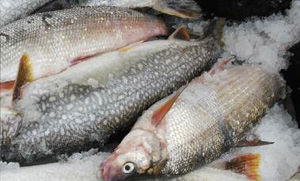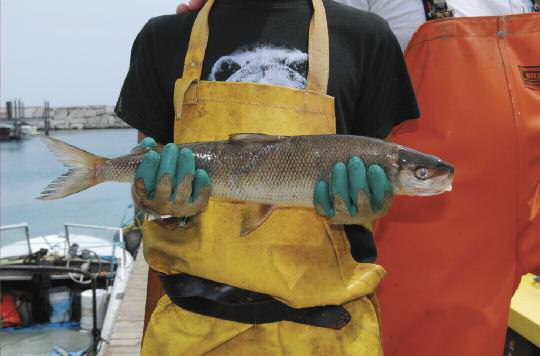FOR ALL THE FISH IN THE SEA
Smart seafood purchases are an investment in ocean health.
WRITTEN BY MIKE COLPO
PHOTOS BY CAROLE TOPALIAN
Fish has been a prized food across virtually every culture since before we began using stones to write on stones. Perhaps it is the mysterious provenance of fish – rising as it does from depths with which we’re less familiar than the surface of the moon – combined with the much-mythologized bounty of the sea, which has led us to take this food source for granted. Why else would we think it perfectly normal to find affordable, all-you-can-eat sushi in the Great Basin, a place named for its isolation from the sea and its mind-expanding absence of water
Most eaters of fish know only this: Fish are plentiful, affordable, and delicious. But a few dedicated nonprofit groups and enlightened business owners are working hard to expand what we know about fish and how we treat this precious resource. It is a change, they argue, that stands to improve our health, the environment, and the vitality of fish populations worldwide, all without breaking the bank.
Elsa Corrigan is one such business owner. Corrigan graduated from the California Culinary Academy in San Francisco, where she learned the ins and outs of what was then a food movement set to explode. At the time, words like sustainability and locavore were not yet part of the cultural dialogue. But they were a key part of Corrigan’s training.
“I’ve never flown an organic flag,” Corrigan says. “It’s just the way you’re supposed to do business.”
Since opening the doors of Mamasake in Squaw Valley’s Olympic Village in 2002, she has – to use her words – done business the way you’re supposed to. Hence, her restaurant features organic and biodynamic beer, wine, and sake selections; biodegradable dry goods; and, most importantly, fresh, responsibly sourced seafood.
Corrigan pays close attention to the latest information provided by groups like the Monterey Bay Aquarium through its Seafood Watch list. It’s one of the reasons customers will not find certain fish on Mamasake’s menu. Varieties that have either been removed from the menu or never offered include bigeye tuna, Chilean sea bass, marlin, mahi mahi, tilapia, and shrimp sourced from suppliers who use either dredging or trawling in their harvest practices.
BEST CHOICES
But pocket guides aren’t the ultimate resource. And their simplicity is both a blessing and a curse, says Alisha Lumea, director of communications for CleanFish, a mission-driven, San Francisco-based business that seeks to connect seafood consumers to providers, much in the same way that farmers’ markets help bring customers closer to food growers. Lumea understands why consumers are drawn to the simplicity of seafood watch lists. Unfortunately, she argues, the current seafood business model is anything but simple. And too much emphasis on easy solutions could leave many thoughtful, small-scale suppliers high and dry. This is where CleanFish comes in.
The humble shrimp helps illustrate Lumea’s case. A quick glance at the online version of the Seafood Watch list reveals that shrimp show up in every part of the list, from the list of seafood to avoid to the best choices list. Wild-caught white shrimp often are on the list to avoid (thanks largely to irresponsible harvesting practices). But those who purchase CleanFish’s Fisherman’s Daughter Wild Sonora Coast Shrimp get shrimp that is caught in the wild by a family-owned company dedicated to reducing by-catch (the unintended casualties of trawling methods). The company has a vested interest in stewarding the resource upon which they depend. And their success could mean a revolution for their region, encouraging other small-scale suppliers like them to take the risk of switching to more sustainable fishing methods.
By zeroing in on what so many consumers are looking for – namely, a clearer and more direct connection to where their food comes from – CleanFish is hoping to clarify confusing choices by providing branded traceability. It’s another way of approaching what Elsa Corrigan does at Mamasake: getting to know suppliers, learning how they source their seafood, sharing information openly, and developing trust in their product.
CONSUMER DEMAND
For consumers who are committed to sustainable choices but still hungry for seafood, there are few easy answers. Fortunately, the best advice professionals such as Corrigan and Lumea can offer also is pretty simple: Look for information on restaurant menus and literature in shops. Business owners who offer sustainable seafood are proud of that. And they will offer information and welcome your questions about their products.
When it comes down to it, supporting a sustainable seafood industry is about being an engaged consumer. Or as Lumea puts it, “Making positive changes is as much about saying ‘yes’ to the right things as it is about saying ‘no’ to the wrong ones.”
Mike Colpo is a local writer and editor. He enjoys following food from source to supper plate.
Resources
You don’t have to go to the most expensive restaurants to find fresh, responsibly harvested seafood, says Mimi Butler of Reno’s Buenos Grill (Buenosgrill.com).

“We tend to keep our menu pricing the same,” says Butler. “So it is a concern to keep costs down when purchasing seafood, as well as to purchase wisely regarding the sustainability of the fish. It is doable, especially if the restaurant owner discusses with their purveyors that purchasing sustainable seafood is a priority.”
The best way to tell which businesses are offering responsibly harvested fish from sustainable stocks is to simply ask.
This can be daunting for some. So here are a few things to look for to get a sense if your questions will be well received:
CHECK THE INTERNET
A website is the easiest place for a restaurant to offer updated information on their products, and the homepage or “about” section is where you should find it. 4th St. Bistro’s homepage (4thstbistro.com) describes its cuisine as: “Market driven, fresh, sustainable, local, seasonal, with most of the menu featuring local, organic farm produce.”
CHECK THE MENU
Restaurateurs who have put in the time and effort to track down environmentally responsible products are proud of their offerings. This statement is found on Sezmu’s menu (Sezmurestaurant.com): “We support ranchers and farmers who practice ecologically sound and organic agriculture.” It’s a strong clue your questions about sustainable seafood will be welcomed.
CHECK THE RESTAURANT
What kind of establishment is it? An independently owned café with a seasonally appropriate seafood offering usually has sustainable selections. An all-you-can-eat buffet likely will not. Some who carry sustainable seafood from Clean Fish and others in our area, besides the ones already mentioned in the story, include Barone & Reed Food Company in Minden (Baroneandreed.com), Café Girasole in Gardnerville (Cafe-girasole.com), Blue Water Bistro in South Lake Tahoe (Bluewaterbistrotahoe.com), and Edgewood Golf Course in South Lake Tahoe (Edgewoodtahoe.com).
FISH TO GO
You can pick up sustainable fish choices ready for your enjoyment here:
European Food Emporium, Reno, Eurofoodemp.com
Great Basin Community Food Co-op, Reno, Greatbasinfood.coop
New Moon Natural Foods, Tahoe City and Truckee, Newmoonnaturalfoods.com
Overland Meats, South Lake Tahoe, Overlandmeatco.com
Village Meats, Incline Village, Villagemeats.com
Whole Foods Market, Reno, Wholefoodsmarket.com/reno
REMEMBER
The information on a seafood-buying guide is not a foreclosure on dialogue, but an invitation to start one. Appearance of a fish variety on the avoid list among a business’ offerings should not be taken as an immediate and unequivocal sign of irresponsibility on the part of the proprietor. Restaurants and fishmongers care deeply about what they serve and strive to take pride in it. Their job is to provide us with responsibly harvested seafood from well-managed sources. But the consumer’s job is to ask for it.
GOOD READS
Nick Joy’s three-part series on genetically modified salmon (Huffingtonpost.com/nick-joy): A managing director of an operating fish farm speaks out about the dangers of GM salmon.
Four Fish: The Future of the Last Wild Food by Paul Greenberg: An environmental journalist looks at the historical and future impacts of our appetite for salmon, sea bass, cod, and tuna.
Business and Purchasing Resources
CleanFish (Cleanfish.com): “A company, an aspiration, and a movement” that seeks to change business-as-usual across the entire seafood supply chain.
FishChoice (Fishchoice.com/About-FishChoice.aspx): A business-to-business resource that connects buyers and sellers of sustainable seafood.
I Love Blue Sea (Ilovebluesea.com): Buy direct from a distributor that specializes in transparency and quality.
POPULAR WATCH LISTS
Blue Ocean Institute’s FishPhone (Blueocean.org/fishphone): A wallet-sized buying guide without the paper. Look up the latest information right on your phone.
Monterey Bay Aquarium’s Super Green list (Montereybayaquarium.org/cr/cr_seafoodwatch/sfw_health.aspx
): The folks responsible for the highly popular Seafood Watch pocket guides have condensed their best choices list to a short list of seafood superstars.


